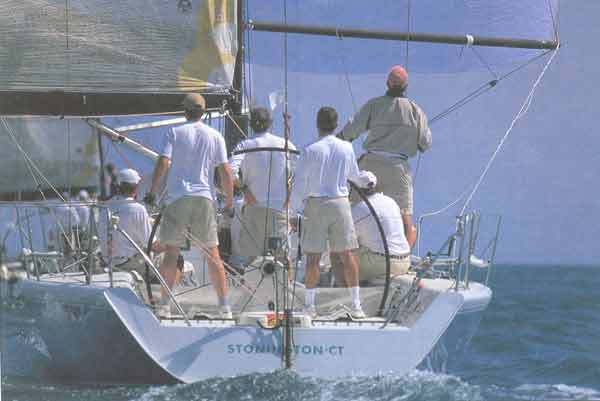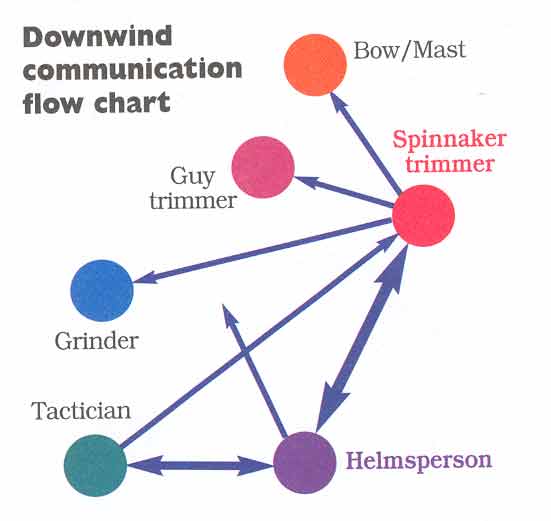 |
| J. H. Peterson photo |
Talk With Your Teammates
by David Dellenbaugh
When you’re sailing down the run, there’s a lot to talk about. Wind pressure in the spinnaker. The feel of the helm. Your angle of heel. Position of the spinnaker pole. If you want to keep going fast, your crew must communicate with each other about what’s happening with the wind, sails and boat. When I am a helmsperson, I like to hear as much information as possible, so I tell my crew to talk a lot and assume that I know nothing.
Here is a list of speed-related subjects
that each member of a crew might talk
about on a run. If your boat doesn’t
have this many crewmembers, you must
divide up these subjects among fewer
people.
 |
| J. H. Peterson photo |
Spinnaker Trimmer
The spinnaker trimmer is a key member of
the downwind speed team because he or
she can see and feel the wind in the
spinnaker.
Pressure in the spinnaker. Is the sail
nicely powered up or is it barely
holding its shape? Was there a recent
change in pressure? Would the spinnaker
be happier if the boat was heading
higher or lower?
For example, the trimmer might say
something like: “I have better pressure
now, we can come down 5 degrees.” Or
“I’m losing pressure, it would help to
head up a little.” This is the heart of
what the spinnaker trimmer must
communicate to keep the boat going fast.
Note that the spinnaker trimmer
describes pressure in the sail and then
offers an opinion about what is needed
to keep the boat going as fast as
possible. He or she should not say to
the helmsperson, “I have more pressure.
Come down please.” The choice of whether
to head up or down should always be left
up to the helmsperson (and/or the
tactician) and is based on a number of
factors like strategy and tactics, plus
the information that’s communicated by
the trimmer.
Commands to the grinder about trimming
the sheet. The trimmer should tell the
grinder when to start trimming (“Trim!”)
and when to stop (“Stop!”). Once the
grinder hears “Trim,” he or she should
trim as fast as possible and keep going
until they hear “Stop.” Don’t forget to
say “Thanks!”
Requests about other spinnaker controls.
In addition to the sheet, the spinnaker
trimmer must oversee the afterguy,
foreguy and topping lift. If the boat is
big enough that the trimmer cannot reach
or handle all these controls, he or she
must talk with other crewmembers. For
example, “Can you square the guy back a
foot please?” or “Please drop the
outboard end of the pole six inches.”
Observations about potential bad air or
windshifts. The spinnaker is a very
sensitive sail, so the trimmer is often
able to recognize the effects of bad air
or a lift or header before anyone else
on the boat. When you feel this, tell
the helmsperson or tactician.
The Helmsperson
The helmsperson has the ultimate
responsibility for making the boat go
fast and is critical because he or she
can feel the boat through the wheel or
tiller.
Feeling about boatspeed. The helmsperson
should report on his or her sense of how
fast the boat is going. Are you
accelerating, decelerating, sailing too
fast, too slow, and so on? It’s
important for everyone to know this so
they can keep the boat going as fast as
possible and anticipate what the
helmsperson might do next.
Placement of crew weight. The
helmsperson should feel how much
windward or leeward helm there is, and
use this info to direct the placement of
crew weight, both fore-and-aft and
side-to-side.
Description of your strategy. This is
important so everyone is on the same
page. For example, what angle and/or
speed are you trying to sail. Do you
want to go high and fast? Low and slow?
Or exactly on your target speed numbers?
It will help to give the crew a target
boatspeed, a target wind angle, a target
spinnaker pole angle or just a point on
shore where you are steering.
Questions of other people. Ask questions
to keep the crew on their toes and to
make sure you have the info you need to
steer fast.
Tactician
The tactician is responsible for
coordinating speed information with
strategic and tactical concerns.
Performance relative to other boats
nearby. Comparing your speed to other
boats is really the only way to know how
fast you are going, so this is critical.
To avoid confusion, always talk about
your boat. For example, “we are lower
and faster.” “We are the same height and
slower.”
Tactical/strategic concerns. What
factors, if any, may affect the course
you would sail for optimal speed? For
example, should you sail a little high
to avoid bad air or to get into better
wind pressure?
Reminders about your target speed. On
bigger boats with instruments, the
tactician should help decide what target
speed to sail and keep evaluating this
number as conditions change. Your target
speed should take into account your
performance relative to other boats and
tactical or strategic concerns.

Other Crewmembers
All other crewmembers should be
encouraged to contribute comments about
boatspeed, too. For example, someone
sitting on the weather rail may have a
great perspective on your performance
relative to other boats. And if they
have few other responsibilities, they
may be able to focus on one boat for a
while and give good feedback on your
speed.
Reports on puffs and lulls. Other crew
are often assigned the job of looking
for upcoming changes in wind pressure.
Remember to look in the direction of the
boat’s apparent wind (use your masthead
wind pennant) to see where your puffs
and lulls are coming from.
Dave publishes the newsletter Speed &
Smarts. For a subscription call:
800-356-2200 or go to:
www.speedandsmarts.com